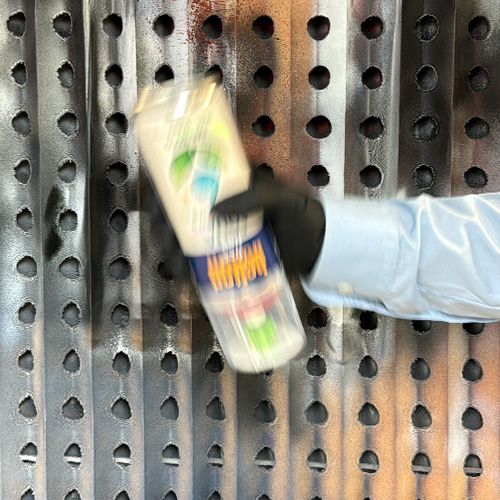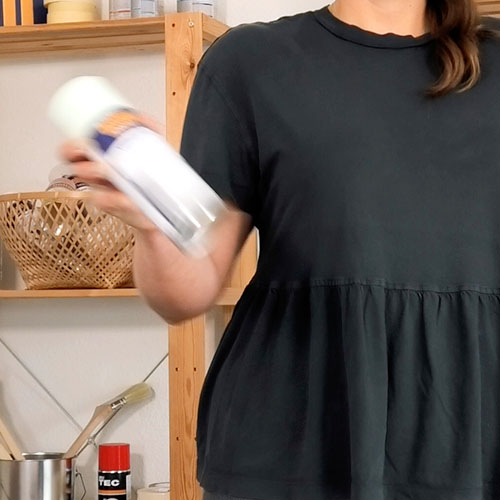FAQ

Hold the can as vertical as possible because the pressure can decrease depending on the angle of inclination.

There are different spray nozzles in the belton range. These are matched to the respective spray paint product, the painting requirements and the surface being painted.
In addition to the standard round jet spray nozzle that is used on most belton spray paints, there is a second spray nozzle e.g. for the belton free: the broad beam or fan spray nozzle that can be adjusted infinitely both horizontally and also vertically.

If the spray can is not empty, shake again until the mixing balls can be heard. It is possible that the valve is clogged. In this case, wipe off any residues on the spray nozzle, turn the spray can upside down and spray briefly twice.

If the mixing balls cannot be heard despite thorough shaking of the can, do not subject the can under no circumstances subject the can to mechanical stress, e.g. by knocking it open. In this case we recommend turn the can upside down and shake it thoroughly upside down.

The drying times vary depending on the type of paint, painted object, surface, temperature, humidity and layer thickness. The precise drying times are stated on the respective product sub-page or on the label of the spray can.
In general, this information can be summarised as follows:
- Solvent-based spray paints are dust-dry after about 20 minutes, dry-to-touch after about 2 hours and completely dry after about 24 hours.
- Water-based spray paints (e.g. belton free or belton perfect) are dust-dry after about 45 minutes, dry-to-touch after about 3 hours and completely dry after about 24 hours.

You can avoid adhesion problems by preparing the painting surface correctly. The surface should always be dry, clean and free of grease. In the case of problematic surfaces, for instance plastic and polystyrene, always use the corresponding belton basic primer.

You can avoid drips being created in a number of ways. Firstly, ensure that the spray distance to the painted object is not too small. 15 – 25 cm is ideal. Also, excessive amounts of paint should not be applied in one paint coat. Instead, you should paint in several thin layers and observe the product-specific flash time (see → "What is the flash time?").

There are various reasons for colour differences. If the spray can is not shaken properly, the pigments may not be distributed adequately. Before spray painting, shake the can thoroughly for at least 2 minutes, starting from the time when the mixing balls can be heard. It is also possible that not enough paint layers were applied causing the surface or primer to shine through, and falsify the colour.
In case of special paints, like metallic colours, the colour difference can also be due to different spray distances. If the spray distance is too low, the colour is darker than if the spray distance is too high. You can avoid this by maintaining a constant spray distance of approx. 15 - 25 cm.

Paint turns white, if it is applied when the humidity is too high. The grey coat can be polished off after the paint has completely dried. You can prevent this effect by spray painting at a temperature between 20 – 25 °C at low humidity.

Store and transport the spray can in an upright position, in a dry, cool place protected against direct sunlight and chemical and mechanical influences.

A spray can should be used until no more paint comes out when the spray nozzle is pressed. The can is only completely empty after this. Completely empty spray cans are reused or recycled via a recycling collection point (yellow bin, yellow sack, container for lightweight packaging). Cans with content need to be disposed of via the hazardous waste system.

All different causes:
Is the painted surface made of plastic? Before applying the paint, check whether the spray paint is suitable for plastic. Otherwise, apply the belton basic plastic primer first.
Cracks could also occur, if a high-pigment paint (e.g. primer) was painted onto a low-pigment paint (e.g. topcoat). Therefore, the following paint structure must be observed: Primer → Base coat → Topcoat. Find out more here: The right product combination.
Cracks can also be formed if the paint coat is created with different types of paint. Therefore, try to always use the same product line from the same manufacturer for the entire paint structure to prevent incompatibilities.

This rough surface is created due to an excessively large spray distance. The paint that has dried in the air (spray mist) lands on the surface and no longer flows. If other layers are painted over dents will be formed.

The paint is applied in several even thin layers. Wait about 3 – 10 minutes between spray coats. There is more information about the precise times on the spray can label or on the respective product page.

Paint can be applied both indoors and also outdoors subject to the weather, good ventilation and after taking health & safety into consideration. Also check that there is no wind.

Ensure that you maintain an even speed and the same distance (about 15 – 25 cm). If the painting speed is too high, spray mist can be created that leaves a rough surface behind. If the painting speed is too slow, overspray may occur that can lead to dripping. It is advisable to practice your painting speed on a test object first. The ideal distance is stated on the spray can label or the respective product sub-page.

- 2K (2-component) paints have a high resistance to petrol and chemicals.
- Our paints used in the "belton" area are 1K (1-component) products.
- These are mostly weather and UV resistant, but only partially or not sufficiently resistant to petrol and chemicals.
Tip: If, however, e.g. a few drops of petrol get onto the paint surface, dab them off immediately with an absorbent cloth or cotton cloth. Never rub or rub in.

The painted object should always be clean, dry, grease-free and possibly pre-treated with a suitable cleaning agent. Adhesion on some surfaces is approved, if they are slightly sanded first. See also → Sanding.

Depending on the product line or product, the valve cap may vary. There are precise instructions about how to remove the valve cap on the respective product sub-page. We always recommend removing the lock with a screwdriver.

We recommend that you wear gloves, a safety mask and goggles as personal protective equipment when using the belton spray cans.

We generally recommend sanding the surface to improve the adhesion of the subsequent topcoat. The higher the number of pores of the sandpaper, the finer the sanded finish. Example: P2000 is finer than P180

As a general rule, we recommend shaking the can intensively for 2 minutes until the mixing beads are audible.
For belton free (water-based paint), we recommend shaking the can for a maximum of 1 minute.

Depending on the product line or product, the spray lock may vary. There are precise instructions about how to remove the lock on the respective product sub-page. We always recommend removing the spray lock with a screwdriver.

Every time after spraying the paint, turn the can upside down and press the spray nozzle until no paint, only propellant comes out. Otherwise, the dip tube can become clogged and the spray can may malfunction. Observe the information on the respective spray can.

Every time you apply spray paint, always start outside the painted object to avoid overcoating during painting.

To avoid painting errors, test spray after shaking the can. Either on a test object or a concealed part of the painted object. This allows you to check the function, colour and compatibility of the surface.

There may be several reasons for this: Possibly, the can has not been shaken correctly; reshake again for about 2 minutes. It is also possible that the spray can or the contents are too cold; in this case, the spray can should be warmed slowly up to the recommended processing temperature. Another reason could be dried product residues in the dip tube or valve. In this case, turn the spray can upside down and spray twice so that the propellant releases the residues and transports them to the outside. Always ensure that the finger is placed in the correct position on the spray nozzle, so that no paint residues remain on fingers or the can after it exits the can.

This effect is called paint ‘lifting’. This occurs when an artificial resin paint is coated with another type of paint or with itself, after it has completely dried out because artificial resin paints are oxidative-drying paints (air drying). After about 6 hours, the artificial resin paint is completely dry and should not be painted over, otherwise the new coat of paint adds solvents again and the lower coat of paint swells.

If you want to spray paint inside, ensure an adequate air supply to avoid unpleasant odours. You should also wear a respiratory mask in closed rooms. Do not spray in windy conditions because the spray mist will otherwise be applied unevenly.

Dust-dry: the upper paint layer has dried to the extent that dust particles no longer stick in the paint.
Dry-to-touch: the paint has not yet completely hardened and, although it cannot bear any mechanical loads, it can be touched.
Completely dry: the paint is completely dry but it has not yet reached final hardness.
Depending on the spray paint and layer thickness, the painted object can be subject to mechanical loads after approx. 7 – 14 days.

The flash time or flash-off time is the waiting period between several spray coats on the same painted object. Often, 2 – 3 spray coats are required to create an even, closed paint film. A flash-off time of 3 – 10 minutes should be observed between spray coats. There is more information on the spray can label or on the matching product sub-page.

This effect may have several causes. If the spray distance is too great, the paint will dry in the air and is applied then as ‘spray mist’. This creates the rough surface. You can avoid this by maintaining a constant painting distance of approx. 15 - 25 cm. The shine may disappear due to an excessively hot painted surface or when painting in bright sunlight. Due to the heat, the solvent can no longer escape on the surface and blisters occur that stop the surface from shining. Swirling dust can also cause this to happen. If possible, select a place to paint that is protected from the sun and wind at an ideal temperature of between 20 – 25 °C and low humidity.

The ideal work temperature lies between 15 – 25 °C, however spray painting is also possible between 5 – 35 °C. Different temperatures can lead to changes in the paint behaviour: If the paint temperature is too high, the paint will dry more quickly, at low temperatures the paint dries more slowly. Do not spray paint in frost or below 5° and not during hot temperatures above 35°C.

![[Translate to English:] FAQ](/fileadmin/user_upload/Header/belton-faq_1920x700.jpg)